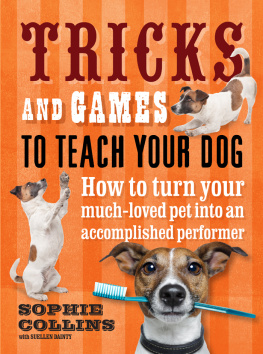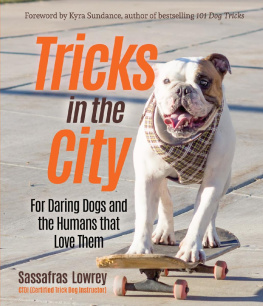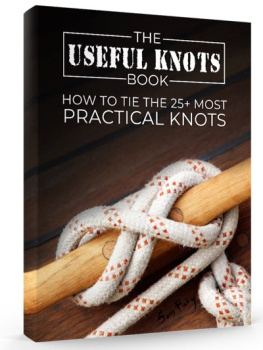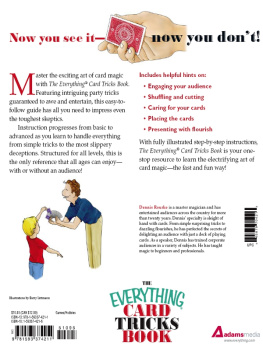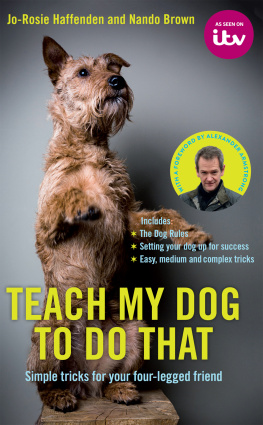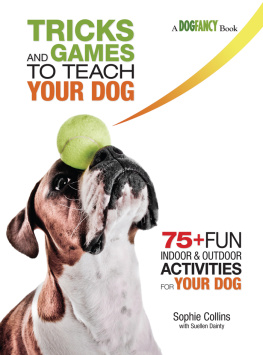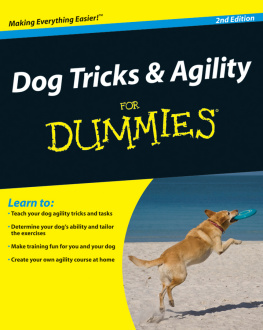
Aim to put the fun back into your dogs playtime by discovering a wealth of safe, imaginative games and easy-to-teach tricks to enjoy with your dog. Whatever the breed, age or temperament of your pet, you will find tricks and games here to suit all levels of skill from the simple to the challenging, with plenty of options in between. Engage your dog in activities he will enjoy and amaze and impress your family and friends as well!
Fun options to suit every dog, whatever his breed or age.
Dozens of ideas to put the joy back into playtime.
Step-by-step photos that break down tricks and games into easy-to-follow stages.
Positive, friendly training methods that help you bond with your canine companion.
TRICKS
AND GAMES
TO TEACH YOUR DOG
SOPHIE COLLINS
with SUELLEN DAINTY

First published in the UK in 2012 by
Ivy Press
210 High Street
Lewes
East Sussex BN7 2NS
United Kingdom
www.ivypress.co.uk
Copyright Ivy Press Limited 2012
All rights reserved. No part of this book may be reproduced or transmitted in any form or by any means, electronic or mechanical, including photocopying, recording, or by any information storage-and-retrieval system, without written permission from the copyright holder.
British Library Cataloguing-in-Publication Data
A catalogue record for this book is available from the British Library
Print ISBN: 978-1-908005-69-4
EPUB ISBN: 978-1-78240-180-3
MOBI ISBN: 978-1-78240-181-0
Material in this book first appeared in 50 Games to Play With Your Dog (2008) and 50 Tricks to Teach Your Dog (2011).
This book was conceived, designed and produced by
Ivy Press
Creative Director Peter Bridgewater
Publisher Susan Kelly
Art Director Wayne Blades
Senior Editor Jayne Ansell
Designer Ginny Zeal
Photographer Nick Ridley
Illustrator Joanna Kerr
This book has been published with the intent to provide accurate and authoritative information in regard to the subject matter within. While every reasonable precaution has been taken in preparation of this book, the author and publisher expressly disclaim responsibility for any errors, omissions or adverse effects arising from the use or application of the information contained herein. The techniques and suggestions are used at the readers discretion and are not to be considered a substitute for veterinary care. If you suspect a medical problem consult your vet.
The author and publisher would like to thank the following for permission to reproduce photographs: A. Inden/zefa/Corbis, (see ).
Contents

Introduction
H ow much does play matter to your dog? If he has good food, plenty of exercise and somewhere comfortable to rest during his downtime, do you really need to play with him, too? Or spend your own downtime teaching him tricks? Well, yes. Why? Theres a whole host of arguments for teaching your pet lots of games and tricks, but here are just a few of them:


Dogs are one of the few species humans are one of the others to enjoy play as adults. There are social, practical reasons for this, as research suggests that dogs use play both to learn things and to get rid of stress. Dogs are clever some very clever and, just like people, they need to stretch their minds as well as their bodies to stay healthy and avoid boredom (and remember, a bored, bright dog may well be a dog that gets himself into mischief). As social mammals, dogs need plenty of interaction, too, whether thats with you, their honorary pack leader, or other dogs, and play is one of the most enjoyable ways to interact.
Teaching your pet reinforces your role as his leader, and will help to build the bond you already have together. If your dog is used to looking to you for his fun, then it should also be easier for you to catch and deflect his attention when hes thinking about something you dont want him to do whether its barking at the postman or bounding up over-enthusiastically to an unknown dog.
You can use games both to reinforce trust and to convince your dog that youre his best buddy. If your dog tends to act on his own initiative sometimes a bit more than youd like him to then having fun with you can also lead him to look more naturally to you for guidance when an unfamiliar situation arises. Independent dogs are often the brightest (and they might be the ones who would manage best if they had to live in the wild), but they can also be the hardest to manage as domestic pets if they arent given clear guidance.
Things to bear in mind: Start and finish every session, whether youre teaching a trick or playing a game, with something your dog is completely familiar with, so you ensure you always begin and end with good vibes. If your dog seems slow to pick things up, take your time and keep learning sessions short: dogs learning rates are very, very variable. Teach little and often, and stay calm and upbeat. Never push your dog too hard; if hes looking frustrated or fed up, youve gone on for too long and the most important thing of all is that you both have fun!

Keep it Safe
T he tricks and games that follow include some options for every kind of dog: small, large, young, or old. Even if your beloved pet is elderly or hasnt spent much time learning new things, therell still be some simple ideas youll find that you can teach her. Do pay attention to the boxes on the pages they offer safety advice when its necessary and include other useful information and alternative suggestions for different elements for a game or trick to make it suitable for small or large breeds.
Pay attention to your dog when youre teaching active tricks. Usually, if a dog finds it physically uncomfortable to do a trick, shell refuse to try it, so if shes normally eager to earn rewards and attention but is failing to engage with a particular game, it may not be the right one for her. Never assume that your pet is being obstinate if she doesnt appear to want to do something, and never coerce her physically; not only is this ineffective, it may have the very undesirable side effect of making her scared of you or even of playing in general.

Jumping, in particular, should be taught carefully. Puppies shouldnt strain their joints while they are still growing, and elderly dogs who have back problems or who are stiff in the hips shouldnt jump or try any game that involves crawling on their bellies. Stick to some of the more mentally stimulating options if you have a dog who isnt very strong or agile physically.
And one last warning: work with objects that are safe for your dog to play with. Toys manufactured specifically for dogs are the best options for hunt- or bring-the-object games. If you have a very mouthy dog who is strongly focused on mouthing and chewing any object that comes into her path, teach any collecting games with suitable props nothing too small or that can be too easily chewed to pieces.
Next page
